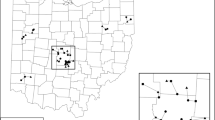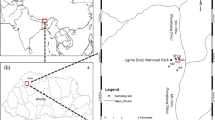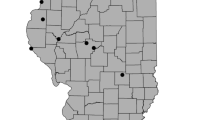Abstract
Anthropogenic alteration of the landscape has facilitated plant community change and non-native species invasion in urban areas. We used species occurrence data from over 2000 wetlands within the Chicago metropolitan region to classify urban wetlands into community types and examined non-native species composition across community types. Non-native species were widespread across the region, occurring in over 99% of wetlands. On average, 35% of the plant species in individual wetlands were non-native. A single non-native species, Phalaris arundinacea, was present in 74% of wetlands. Six wetland community types were identified (wet meadows, marshes, forested wetlands, farmed wetlands/mudflats, roadside marshes, and an undetermined wetland type), with each having aggressively spreading non-natives amongst the most common plant species. We conducted canonical correspondence analysis to evaluate the contribution of surrounding land cover, roads, and location of wetlands to plant community composition in these wetlands, and found that similar changes to the landscape have resulted in similar combinations of native and non-native species. Differences in species composition reflected spatial gradients in land use from urban to rural areas across the region, as well as proximity to major roads. Anthropogenic drivers have resulted in profound and pervasive changes to wetland communities across the region, creating novel habitats and ultimately novel community types.




Similar content being viewed by others
References
Alpert P, Bone E, Holzapfel C (2000) Invasiveness, invasibility and the role of environmental stress in the spread of non-native plants. Perspect Plant Ecol 3(1):52–66. https://doi.org/10.1078/1433-8319-00004
Angel J (2011) Illinois climate normals. Illinois State Water Survey, Prairie Research Institute: University of Illinois at Urbana-Champaign. http://www.isws.illinois.edu/atmos/statecli/newnormals/newnormals.htm. Accessed 5 Jan 2017
Aronson J, Murcia C, Kattan GH, Moreno-Mateos D, Dixon K, Simberloff D (2014) The road to confusion is paved with novel ecosystems: a reply to Hobbs et al. Trends Ecol Evol 29(12):646–647. https://doi.org/10.1016/j.tree.2014.09.011
Aronson MFJ, Handel SN, La Puma IP, Clemants SE (2015) Urbanization promotes non-native woody species and diverse plant assemblages in the New York metropolitan region. Urban Ecosyst 18(1):31–45. https://doi.org/10.1007/s11252-014-0382-z
Bivand R, Keitt T, Rowlingson B (2014) Rgdal: bindings for the geospatial data abstraction library. R package version 0.9–1. http://cran.r-project.org/package=rgdal
Borcard D, Gillet F, Legendre P (2011) Numerical ecology with R. Springer, New York. https://doi.org/10.1007/978-1-4419-7976-6
Bowman Cutway H, Ehrenfeld JG (2009) Exotic plant invasions in forested wetlands: effects of adjacent urban land use type. Urban Ecosyst 12(3):371–390. https://doi.org/10.1007/s11252-009-0088-9
Bowman Cutway H, Ehrenfeld JG (2010) The influence of urban land use on seed dispersal and wetland invasibility. Plant Ecol 210(1):153–167. https://doi.org/10.1007/s11258-010-9746-5
Brauer J, Geber MA (2002) Population differentiation in the range expansion of a native maritime plant, Solidago sempervirens L. Int J Plant Sci 163(1):141–150. https://doi.org/10.1086/324047
Brisson J, de Blois S, Lavoie C (2010) Roadside as invasion pathway for common reed (Phragmites australis). Invasive Plant Sci Manag 3(04):506–514. https://doi.org/10.1614/IPSM-09-050.1
Choi YD, Bury C (2003) Process of floristic degradation in urban and suburban wetlands in northwestern Indiana, USA. Nat Areas J 23:320–331
Cowardin LM, Carter V, Golet FC, LaRoe ET (1979) Classification of wetlands and deepwater habitats of the United States. U.S. Department of the Interior, fish and wildlife service: Washington, DC. FWS/OBS-29–31
Cunningham MA, Snyder E, Yonkin D, Ross M, Elsen T (2008) Accumulation of deicing salts in soils in an urban environment. Urban Ecosyst 11(1):17–31. https://doi.org/10.1007/s11252-007-0031-x
De Cáceres M, Legendre P (2009) Associations between species and groups of sites: indices and statistical inference. Ecology 90(12):3566–3574. https://doi.org/10.1890/08-1823.1
Early Detection & Distribution Map** System (2015) Status of invasive plants in Illinois. Center for Invasive Species and Ecosystem Health, University of Georgia. http://www.eddmaps.org/tools/statereport.cfm?id=us_il. Accessed 5 Jan 2017
Environmental Laboratory (1987) Corps of Engineers wetland delineation manual. Technical Report Y-87-1. US Army Corps of Engineers, Vicksburg, MS
ESRI (2014) ArcGIS 10.2.2 for desktop. ESRI, Redlands
ESRI, Tom Tom North America (2013) U.S. and Canada detailed streets, data & maps for ArcGIS, 2013 - Street Map North America. ESRI, Redlands
Forman R, Alexander L (1998) Roads and their major ecological effects. Annu Rev Ecol Syst 29(1):207–231. https://doi.org/10.1146/annurev.ecolsys.29.1.207
Forman RTT, Sperling D, Bissonette JA, Clevenger AP, Cutshall CD, Dale VH, Fahrig L, France R, Goldman CR, Heanue K, Jones JA, Swanson FJ, Turrentine T, Winter TC (2003) Road ecology: science and solutions. Island Press, Washington DC
Foxcroft LC, Rouget M, Richardson DM, Mac Fadyen S (2004) Reconstructing 50 years of Opuntia stricta invasion in the Kruger National Park, South Africa: environmental determinants and propagule pressure. Divers Distrib 10(5-6):427–437. https://doi.org/10.1111/j.1366-9516.2004.00117.x
Galatowitsch SM, Anderson NO, Ascher PD (1999) Invasiveness in wetland plants in temperate North America. Wetlands 19(4):733–755. https://doi.org/10.1007/BF03161781
Galatowitsch SM, Whited DC, Lehtinen R, Husveth J, Schik K (2000) The vegetation of wet meadows in relation to their land-use. Environ Monit Assess 60(2):121–144. https://doi.org/10.1023/A:1006159028274
Gavier-Pizarro GI, Radeloff VC, Stewart SI, Huebner CD, Keuler NS (2010) Housing is positively associated with invasive exotic plant species richness in New England, USA. Ecol Appl 20(7):1913–1925. https://doi.org/10.1890/09-2168.1
Gelbard JL, Belnap J (2003) Roads as conduits for exotic plant invasions in a semiarid landscape. Conserv Biol 17(2):420–432. https://doi.org/10.1046/j.1523-1739.2003.01408.x
González-Moreno P, Diez JM, Ibáñez I, Font X, Vilà M (2014) Plant invasions are context-dependent: multiscale effects of climate, human activity and habitat. Divers Distrib 20(6):720–731. https://doi.org/10.1111/ddi.12206
Hallett L, Standish R, Hulvey K, Gardner M, Suding KN, Starzomski B, Murphey S, Harris JA (2013) Towards a conceptual framework for novel ecosystems. In: Hobbs RJ, Higgs ES, Hall CM (eds) Novel ecosystems: intervening in the new ecological world order. John Wiley & Sons, West Sussex, pp 16–28. https://doi.org/10.1002/9781118354186.ch3
Hansen MJ, Clevenger AP (2005) The influence of disturbance and habitat on the presence of non-native plant species along transport corridors. Biol Conserv 125(2):249–259. https://doi.org/10.1016/j.biocon.2005.03.024
Hebbali A (2017) Olsrr: tools for building OLS regression models. R package version 0.4.0. http://cran.r-project.org/package=olsrr
Hijmans RJ (2014) Raster: geographic data analysis and modeling. R Packag Version 2:3–12 http://cran.r-project.org/package=raster
Hobbs RJ, Arico S, Aronson J, Baron JS, Bridgewater P, Cramer VA, Epstein PR, Ewel JJ, Klink CA, Lugo AE, Norton D, Ojima D, Richardson DM, Sanderson EW, Valladares F, Vilà M, Zamora R, Zobel M (2006) Novel ecosystems: theoretical and management aspects of the new ecological world order. Glob Ecol Biogeogr 15(1):1–7. https://doi.org/10.1111/j.1466-822X.2006.00212.x
Hobbs RJ, Higgs E, Harris JA (2009) Novel ecosystems: implications for conservation and restoration. Trends Ecol Evol 24(11):599–605. https://doi.org/10.1016/j.tree.2009.05.012
Hobbs RJ, Higgs ES, Hall CM (2013) Defining novel ecosystems. In: Hobbs RJ, Higgs ES, Hall CM (eds) Novel ecosystems: intervening in the new ecological world order. John Wiley & Sons, West Sussex, pp 58–60. https://doi.org/10.1002/9781118354186.ch6
Hobbs RJ, Higgs ES, Harris JA (2014) Novel ecosystems: concept or inconvenient reality? A response to Murcia et al. Trends Ecol Evol 29(12):645–646. https://doi.org/10.1016/j.tree.2014.09.006
Hodkinson DJ, Thompson K (1997) Plant dispersal: the role of man. J Appl Ecol 34(6):1484–1496. https://doi.org/10.2307/2405264
Hogan DM, Walbridge MR (2007) Urbanization and nutrient retention in freshwater riparian wetlands. Ecol Appl 17(4):1142–1155. https://doi.org/10.1890/06-0185
Hutchinson T, Vankat J (1997) Invasibility and effects of Amur honeysuckle in southwestern Ohio forests. Conserv Biol 11(5):1117–1124. https://doi.org/10.1046/j.1523-1739.1997.96001.x
Iverson LR (1988) Land-use changes in Illinois, USA: the influence of landscape attributes on current and historic land use. Landsc Ecol 2(1):45–61. https://doi.org/10.1007/BF00138907
Joly M, Bertrand P, Gbangou RY, White MC, Dubé J, Lavoie C (2011) Paving the way for invasive species: road type and the spread of common ragweed (Ambrosia artemisiifolia). Environ Manag 48(3):514–522. https://doi.org/10.1007/s00267-011-9711-7
Kalwij JM, Milton SJ, McGeoch MA (2008) Road verges as invasion corridors? A spatial hierarchical test in an arid ecosystem. Landsc Ecol 23(4):439–451. https://doi.org/10.1007/s10980-008-9201-3
Kentula ME, Gwin SE, Pierson SM (2004) Tracking changes in wetlands with urbanization: sixteen years of experience in Portland, Oregon, USA. Wetlands 24(4):734–743. https://doi.org/10.1672/0277-5212(2004)0240734:TCIWWU2.0.CO;2
Kercher SM, Zedler JB (2004) Flood tolerance in wetland angiosperms: a comparison of invasive and noninvasive species. Aquat Bot 80(2):89–102. https://doi.org/10.1016/j.aquabot.2004.08.003
Knight KS, Kurylo JS, Endress AG, Stewart JR, Reich PB (2007) Ecology and ecosystem impacts of common buckthorn (Rhamnus cathartica): a review. Biol Invasions 9(8):925–937. https://doi.org/10.1007/s10530-007-9091-3
Kowarik I (2011) Novel urban ecosystems, biodiversity, and conservation. Environ Pollut 159(8-9):1974–1983. https://doi.org/10.1016/j.envpol.2011.02.022
Lelong B, Lavoie C, Jodoin Y, Belzile F (2007) Expansion pathways of the exotic common reed (Phragmites australis): a historical and genetic analysis. Divers Distrib 13(4):430–437. https://doi.org/10.1111/j.1472-4642.2007.00351.x
Maheu-Giroux M, de Blois S (2006) Landscape ecology of Phragmites australis invasion in networks of linear wetlands. Landsc Ecol 22:285–301
Matthews JW, Spyreas G (2010) Convergence and divergence in plant community trajectories as a framework for monitoring wetland restoration progress. J Appl Ecol 47(5):1128–1136. https://doi.org/10.1111/j.1365-2664.2010.01862.x
Matthews JW, Peralta AL, Soni A, Baldwin P, Kent AD, Endress AG (2009) Local and landscape correlates of non-native species invasion in restored wetlands. Ecography 32(6):1031–1039. https://doi.org/10.1111/j.1600-0587.2009.05863.x
Maurer DA, Zedler JB (2002) Differential invasion of a wetland grass explained by tests of nutrients and light availability on establishment and clonal growth. Oecologia 131(2):279–288. https://doi.org/10.1007/s00442-002-0886-8
McKinney ML (2002) Urbanization, biodiversity, and conservation. Bioscience 52(10):883–890.
McKinney ML (2006) Urbanization as a major cause of biotic homogenization. Biol Conserv 127(3):247–260. https://doi.org/10.1016/j.biocon.2005.09.005
Meunier G, Lavoie C (2012) Roads as corridors for invasive plant species: new evidence from smooth bedstraw (Galium mollugo). Invasive Plant Sci Manag 5(01):92–100. https://doi.org/10.1614/IPSM-D-11-00049.1
Minor ES, Gardner RH (2011) Landscape connectivity and seed dispersal characteristics inform the best management strategy for exotic plants. Ecol Appl 21(3):739–749. https://doi.org/10.1890/10-0321.1
Minor ES, Tessel SM, Engelhardt KAM, Lookingbill TR (2009) The role of landscape connectivity in assembling exotic plant communities: a network analysis. Ecology 90(7):1802–1809. https://doi.org/10.1890/08-1015.1
Mohlenbrock RH (2002) Vascular flora of Illinois: a field guide, 3rd edn. Southern Illinois University Press, Carbondale and Edwardsville
Moore P (1982) Coastal plants take to the road. Nature 297(5867):537–538. https://doi.org/10.1038/297537b0
Moore TLC, Hunt WF (2012) Ecosystem service provision by stormwater wetlands and ponds - a means for evaluation? Water Res 46(20):6811–6823. https://doi.org/10.1016/j.watres.2011.11.026
Morse NB, Pellissier PA, Cianciola EN, Brereton RL, Sullivan MM, Shonka NK, Wheeler TB, McDowell WH (2014) Novel ecosystems in the Anthropocene: a revision of the novel ecosystem concept for pragmatic applications. Ecol Soc 19:12
Murcia C, Aronson J, Kattan GH, Moreno-Mateos D, Dixon K, Simberloff D (2014) A critique of the ‘novel ecosystem’ concept. Trends Ecol Evol 29(10):548–553. https://doi.org/10.1016/j.tree.2014.07.006
Oksanen J, Blanchet F, Kindt R, Legendre P, Minchin PR, O’Hara R, Simpson G, Solymos P, Stevens H, Wagner H (2013) Vegan: community ecology package. R package version 2.0–10. http://cran.r-project.org/package=vegan
Pincetl S (2015) Cities as novel biomes: recognizing urban ecosystem services as anthropogenic. Front Ecol Evol 3:1–5
Price AL, Fant JB, Larkin DJ (2014) Ecology of native vs. introduced Phragmites australis (common reed) in Chicago-area wetlands. Wetlands 34(2):369–377. https://doi.org/10.1007/s13157-013-0504-z
Price EPF, Spyreas G, Matthews JW (in press) Biotic homogenization of regional wetland plant communities within short time-scales in the presence of an aggressive invader. J Ecol. https://doi.org/10.1111/1365-2745.12883
R Core Team (2014) R: a language and environment for statistical computing. R Foundation for Statistical Computing, Vienna
Reinelt L, Horner R, Azous A (1998) Impacts of urbanization on palustrine (depressional freshwater) wetlands—research and management in the Puget sound region. Urban Ecosyst 2(4):219–236. https://doi.org/10.1023/A:1009532605918
Saltonstall K (2002) Cryptic invasion by a non-native genotype of the common reed, Phragmites australis, into North America. Proc Natl Acad Sci U S A 99(4):2445–2449. https://doi.org/10.1073/pnas.032477999
Saltonstall K (2003) Genetic variation among north American populations of Phragmites australis: implications for management. Estuaries 26(2):444–451. https://doi.org/10.1007/BF02823721
Schwartz MW, Thorne JH, Viers JH (2006) Biotic homogenization of the California flora in urban and urbanizing regions. Biol Conserv 127(3):282–291. https://doi.org/10.1016/j.biocon.2005.05.017
Scott NE, Davison AW (1982) De-icing salt and the invasion of road verges by maritime plants. Watsonia 14:41–52
Scott NE, Davison AW (1985) The distribution and ecology of coastal species on roadsides. Vegetatio 62(1-3):433–440. https://doi.org/10.1007/BF00044771
Seastedt TR, Hobbs RJ, Suding KN (2008) Management of novel ecosystems: are novel approaches required? Front Ecol Environ 6(10):547–553. https://doi.org/10.1890/070046
Shih JG, Finkelstein SA (2008) Range dynamics and invasive tendencies in Typha latifolia and Typha angustifolia in eastern North America derived from herbarium and pollen records. Wetlands 28(1):1–16. https://doi.org/10.1672/07-40.1
Skultety D, Matthews JW (2017) Urbanization and roads drive non-native plant invasion in the Chicago metropolitan region. Biol Invasions 19(9):2553–2566. https://doi.org/10.1007/s10530-017-1464-7
Swink F, Wilhelm GS (1994) Plants of the Chicago region, 4th edn. Indiana Academy of Science, Indianapolis
Thiele J, Schuckert U, Otte A (2008) Cultural landscapes of Germany are patch-corridor-matrix mosaics for an invasive megaforb. Landsc Ecol 23(4):453–465. https://doi.org/10.1007/s10980-008-9202-2
Thomas SM, Moloney KA (2015) Combining the effects of surrounding land-use and propagule pressure to predict the distribution of an invasive plant. Biol Invasions 17(1):477–495. https://doi.org/10.1007/s10530-014-0745-7
Tiner RW (2017) Wetland indicators: a guide to wetland formation, identification, delineation, classification, and map**. CRC Press, Boca Raton
Truitt AM, Granek EF, Duveneck MJ, Goldsmith KA, Jordan MP, Yazzie KC (2015) What is novel about novel ecosystems: managing change in an ever-changing world. Environ Manag 55(6):1217–1226. https://doi.org/10.1007/s00267-015-0465-5
U.S. Army Corps of Engineers (2010) Regional supplement to the Corps of Engineers wetland delineation manual: Midwest Region (Version 2.0). In: Wakely JS, Lichvar RW, Noble CV, Berkowitz JF (eds) ERDC/EL TR-10-16. US Army Corps of Engineers, Vicksburg
U.S. Geological Survey (2014) 2011 National Land Cover Dataset. USGS Earth Resources Observation and Science Center, Sioux Falls
Vilà M, Ibáñez I (2011) Plant invasions in the landscape. Landsc Ecol 26(4):461–472. https://doi.org/10.1007/s10980-011-9585-3
von der Lippe M, Kowarik I (2007) Long-distance dispersal of plants by vehicles as a driver of plant invasions. Conserv Biol 21(4):986–996. https://doi.org/10.1111/j.1523-1739.2007.00722.x
von der Lippe M, Kowarik I (2008) Do cities export biodiversity? Traffic as dispersal vector across urban-rural gradients. Divers Distrib 14(1):18–25. https://doi.org/10.1111/j.1472-4642.2007.00401.x
von der Lippe M, Bullock JM, Kowarik I, Knopp T, Wichmann MC (2013) Human-mediated dispersal of seeds by the airflow of vehicles. PLoS One 8(1):e52733. https://doi.org/10.1371/journal.pone.0052733
Wilcox DA (1986) The effects of deicing salts on vegetation in Pinhook bog, Indiana. Can J Bot 64(4):865–874. https://doi.org/10.1139/b86-113
Wilhelm G, Rericha L (2017) Flora of the Chicago region: a floristic and ecological synthesis. Indiana Academy of Science, Indianapolis
Zedler JB (2009) Feedbacks that might sustain natural, invaded, and restored states in herbaceous wetlands. In: Hobbs RJ, Suding KN (eds) New models for ecosystem dynamics and restoration. Island Press, Washington, DC, pp 236–258
Zedler JB, Kercher S (2004) Causes and consequences of invasive plants in wetlands: opportunities, opportunists, and outcomes. Crit Rev Plant Sci 23(5):431–452. https://doi.org/10.1080/07352680490514673
Acknowledgements
We would like to thank the Illinois Department of Transportation for funding the original wetland delineations and the staff of the Illinois Natural History Survey who conducted the wetland delineations. Thanks to Jennifer Fraterrigo, Jonathan Greenberg, George Geatz, Adrianna Krzywicka, Edward Price and three anonymous reviewers for their helpful feedback on this manuscript.
Author information
Authors and Affiliations
Corresponding author
Electronic supplementary material
ESM 1
(DOCX 10 kb)
Rights and permissions
About this article
Cite this article
Skultety, D., Matthews, J.W. Human land use as a driver of plant community composition in wetlands of the Chicago metropolitan region. Urban Ecosyst 21, 447–458 (2018). https://doi.org/10.1007/s11252-018-0730-5
Published:
Issue Date:
DOI: https://doi.org/10.1007/s11252-018-0730-5




